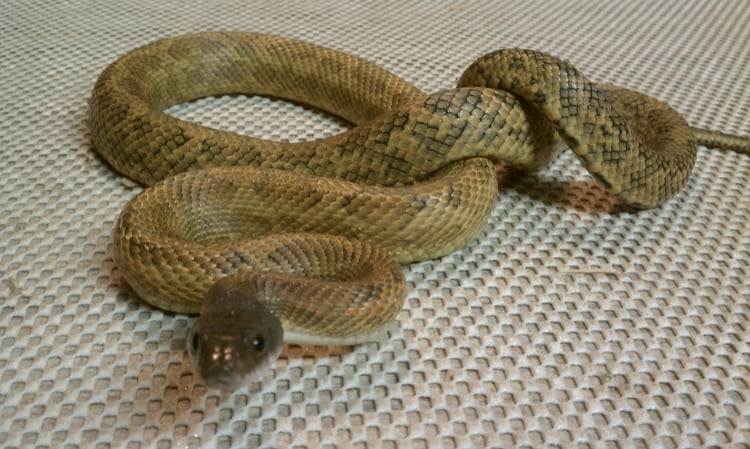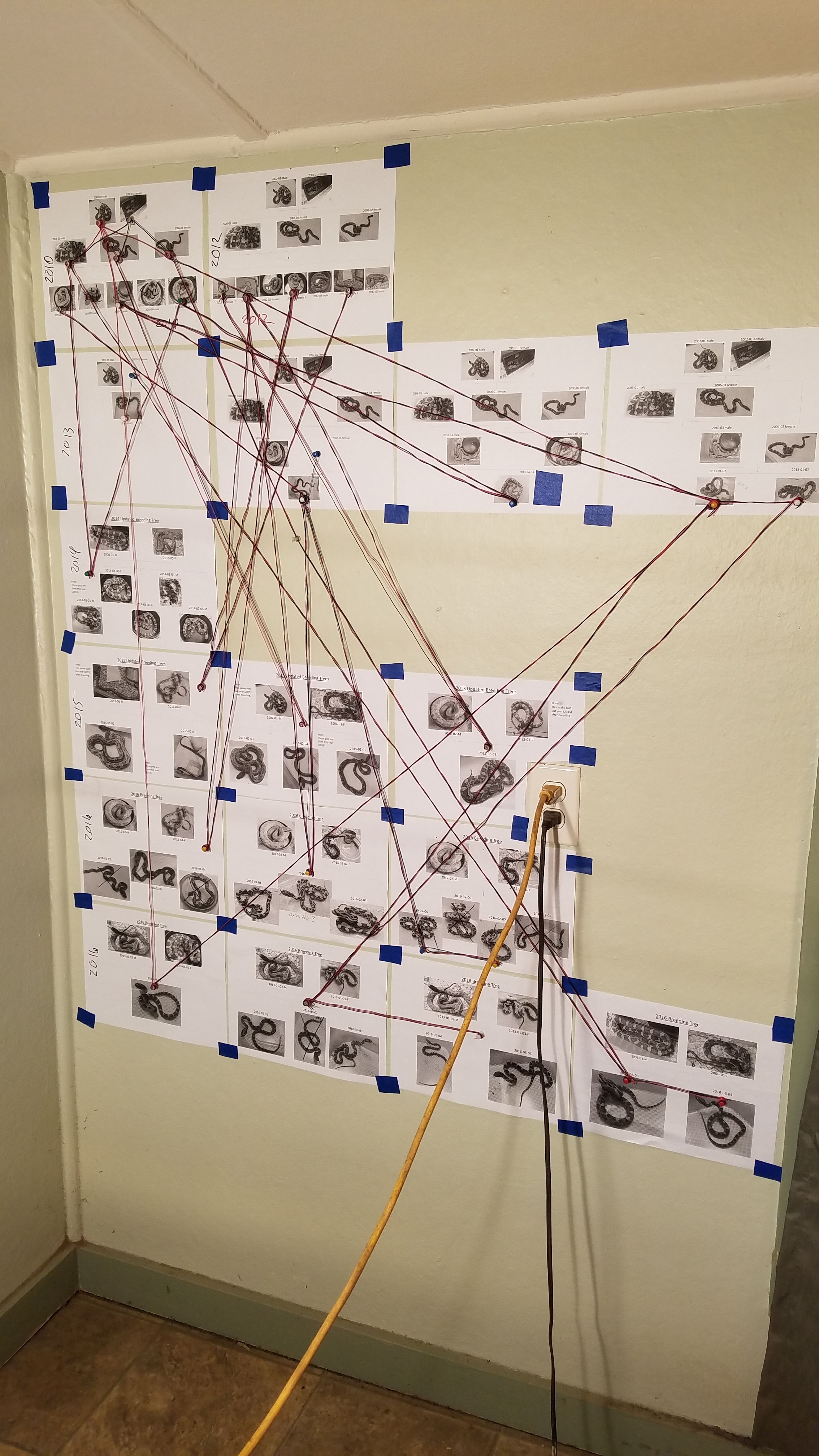Snake Articles (mostly Cadmium Morph news)
The articles on this page will cover my Cadmium Morph breeding project as well as other snake related experiences I have.
2017 babies are hatching!
As this year's babies hatch I'll be documenting/photographing them and comparing them to last year's babies. The next few weeks will be chock full of fun. A quick side note: someone finally explained white balance to me so the pics should be better and the colors more accurate.
June update----I see your true colors
The Thawmaster!!
I only feed frozen/thawed rats & mice. You can argue about that if you like but it's the most efficient way for me to pursue this hobby so I don't want to hear it. For me thawing is essential. For years I've just used a pan of water which had to be filled & refilled with warm water from the sink that wasn't too hot (don't want to cook the mice) but wasn't too cold so that the rats and mice could be close to a natural body temp when fed to the snakes. Tiny pinkies and large rats thaw at different rates and on feeding night I have to repeatedly stop the other things I'm dong to check up on my thawing rodents. BUT NOT ANY MORE! Because I have built the Thawmaster! (I'd trade mark it but it's just a heated water bath built with stuff from Amazon)
I rounded up a 150W heating element, a PID temp controller, a submersible thermocouple, a power cord, and some miscellaneous fittings. Then I just drew it up in CAD, plasma cut the stainless steel sheet metal parts, broke them and TIG welded the whole thing together! Voila! anyone can do it (if they can TIG weld and have a plasma table & press brake)
I know I'm being an ass but an industrious person could use a metal wash tub, pop rivets & JB weld to build basically the same thing.
I didn't document building the tank but here's the leak test. All good.
Then I wired everything up, figured out the programming and tested out the heater. (note: the K-type thermocouple that came with this PID controlled was NOT stainless and quickly rusted, so I replaced it with one that can handle the job.)
I mounted up the controls and ran it to see how it would hold temp. There's regularly a few degrees of variation on this completely un-insulated water bath but it's amazingly accurate for the <$100 total price tag. I was also worried that I might need a pump to circulate the water but it does amazingly well without one.
Here are some pics from right now as I type this. This is my finished prototype and it has runs 6 nights a week for the last month with only one problem which was caused by the thermocouple I replaced.
final note: I put my rodents in ziploc bags and the little mice & rats do just fine but the big rats have sharp nails that always poke holes in the bags so you always get some leakage. Dead rat water that is regularly heated to 100 degrees is a text book example of somewhere to grow horrible bacteria. I change the 6 gallons of water twice per week after thawing large rats and I wash the whole thing out with soapy water at least once per week! I need to find something better than ziplocs. Maybe something washable and reusable.
...but that is a problem for another day.
Snake omelettes?
After my terrible showing with last year's eggs I decided to make 2 changes.
1) I fed more frequently
2) I didn't cool my snakes for as long
The hope was that more food would yield more eggs in females and the short cooling would preserve more sperm in the males.
It's hard to argue with success!
April 21: Female 2012-01-04 / Male 2010-01-02 (10) eggs (0) slugs
April 23: Female 2014-01-02 / Male 2014-01-08 (6) eggs (4) slugs
April 23: Female 2013-01-03 / Male 2014-01-01 (9) eggs (2) slugs
April 24: Female 2013-05-02 / Male 2014-01-04 (13) good eggs
April 27: Female 2006-01-01 / Male 2013-01-02 (19) eggs (0) slugs
April 28: Female 2014-01-03 / Male 2014-01-08 (3) eggs (6) slugs (this as her first time laying)
The youngest snakes (particularly the 2014 males did the worst. Snakes who were at least 4 years old did very well. A lot of factors lend themselves to this, for example how much you feed and how large the snakes are. There's a large body size difference between the 2014 snakes and the 2013 snakes and this translates to success in breeding. (I was once warned by an actual herpetologist that breeding females who they are too small can shorten their lives and stunt their growth so I have always waited until they looked like adult snakes but the breeders I know insist that 2-3 years is all you need and then get to making eggs!)
I still have 3 more females that have not laid yet and I face the problem in 90 days of what to do with all the babies that hatch but that will be this year's challenge and I am starting to plan for that now.
A few folks have contacted me about buying snakes and I certainly need to sell some but I needed to document what I've done and be able to tell people what they are getting. If you look through the pics most of my adults aren't much different than typical Texas ratsnakes from South East and Central Texas so I really wanted to document how these babies change over the first couple years of their lives. I am seeing a spectrum of ground color running from silvery/grey to lemon yellow to pumpkin orange and the dark dorsal patterns vary from typical to almost completely washed out. But which will be which when it's a bucket full of grey babies?
If I've learned anything about life, it's that when you think you know what's going on, start to document & chart it and you'll quickly see that you only knew part of what was going on.
More pics soon!
Easter Eggs!
Well, it's actually the week after Easter but the eggs come when they come. This is the first batch. (2012-01-04 female and 2010-01-02 male)
(10) healthy eggs! Things are already better than last year!
Colors & Patterns Update March (OK, April...)
Spring breeding
It's time, once again, to make matches and hatch babies. In an effort to do better than last year I have started to compile data.
First I needed to see who I have in my breeding pool and what their collective breeding history is. To do this I got a little compulsive. I posted pics of all current snakes and their lineage suing various color wires to track the original breeding pairs. I wish I could have used 2 colors per individual and tracked which half of each set of genetics went where but I have no way of knowing so it's one color per unrelated set of genes (hard to see in the pic). It's not ideal, but it's as accurate as I could get with simple observation.
This was an eye opening graphic of how inbred these animals are. To test the simple recessive traits I need a larger unrelated breeding pool and the ability to raise many more animals. To be honest, I'm not willing to commit to that.
However, this did show me who had not bred, or who had not yet been paired for breeding so this year I concentrated on the "unknown known".
I warmed early, fed more and waited for all the females to cycle through a pre-ovulation shed. So, I'm hoping for good results. The only "iffy" pairing involve the youngest snakes.
In related news, I am working on the quarterly update for the 2016 color change comparison but several of the babies where still in shed. I hope to get that done next week end. Until then put this image of my 2010 male next to any Texas rat snake you've ever seen.
Colors & Patterns Update (December)
colors & patterns
I never realized how hard it was to get accurate indoor pictures using artificial lighting. I have a new appreciation of good photography. Anyway, I did the best I could to ID older snakes in previous pics and start an accurate record of this year's babies.
One more thing before I begin. I've handled hundreds (possibly over a thousand) Texas rat snakes now and I can say without hesitation that they are typically very high strung but some of these animals are calm and pleasant from birth (much more like corn snakes). As I document the change in patterns & colors I will also be adding notes about who is calmer and easier to handle.
Enjoy the snake pics!
























































































